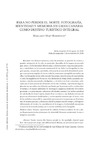Please use this identifier to cite or link to this item:
https://accedacris.ulpgc.es/jspui/handle/10553/59824
| Title: | Para no perder el norte: fotografía, identidad y memoria en Gran Canaria como destino turístico integral | Authors: | Hart Robertson, Margaret | UNESCO Clasification: | 54 Geografía | Keywords: | Turismo experiencial de calidad Destinos maduros de sol y playa Regeneración/redescubrimiento de identidad Memoria sentimental Iconos e imágenes asociados, et al |
Issue Date: | 2016 | Journal: | Cartas diferentes | Abstract: | Los destinos turísticos, como las personas en general, los actores y grandes intérpretes de la vida en particular, dependen de la imagen proyectada para atraer y de la identidad diferenciada y coherentemente expuesta para perdurar y consolidarse en la memoria sentimental de sus fieles. Las fotografías, la imagen captada, compartida y percibida, refuerzan la esencia de la identidad de un lugar o una persona singular al evocar todas las sensaciones intangibles asociadas con ellos. Las fotografías en las redes sociales funcionan como las notas de una melodía o como la magdalena de Proust en A la Recherche du Temps Perdu, activando memorias y estrofas emocionales «desligadas» y a la deriva en el pre-consciente, sofocadas por el peso provincial del ajetreo de la vida cotidiana, experiencias fugaces, placenteras, asociadas con el destino que harán que la persona vuelva a redescubrir el tiempo y el espacio anhelados. Se investiga la asignatura pendiente de la interpretación y re-presentación coherentes del destino turístico (en ambos sentidos) de toda la isla de Gran Canaria, donde el sur se reduce a una fachada ecléctica de proyectos identitarios desdibujados y estereotipados mientras que el norte, cuna de la verdadera esencia de la canariedad, prácticamente no participa en el turismo sino de manera precaria y alternativa desde la perspectiva del tiempo y del espacio diferenciados de la isla y la consolidación de la imagen y la identidad comunitaria a través de la memoria (oral) y su evocación simbólica en la fotografía. Tourist resorts, like famous people in the spotlight, depend upon how their projected image and differentiated identity are presented and repesented to maintain their niche in the competitive experience economy. Photographs and images, shared and perceived, reinforce unique sense of place and identity by evoking all of the intangible associations related to the moment of the snap. Photographs work on social networks like the notes of a haunting melody or Proust’s «madeleine» in his work In Pursuit of Time Forgotten as triggers of memories and emotions buried deep in the pre-conscious and suffocated by the pressure of our daily lives: flashes of pleasant memories associated with a place or person that can be retrieved thanks to a visual evocation of the same. Heritage interpretation and representation can change a tourist resort’s future through the past. A critical interpretation of the island of Gran Canaria is made from the perspective of identity where the overrun tourist South consists of an eclectic mix of everything leading to nothing while the relatively unexplored North of the island maintains the true characteristics of the people and traditions of Gran Canaria, showing how visibilisation of digital humanities and the FEDAC database of photos could re-position the «mini-Continent». |
URI: | https://accedacris.ulpgc.es/handle/10553/59824 | ISSN: | 1699-9037 | Source: | Cartas diferentes [ISSN 1699-9037] (12), p. 87-94 | URL: | http://dialnet.unirioja.es/servlet/articulo?codigo=5915993 |
| Appears in Collections: | Artículos |
Page view(s)
17
checked on Dec 30, 2023
Download(s)
16
checked on Dec 30, 2023
Google ScholarTM
Check
Share
Export metadata
Items in accedaCRIS are protected by copyright, with all rights reserved, unless otherwise indicated.
